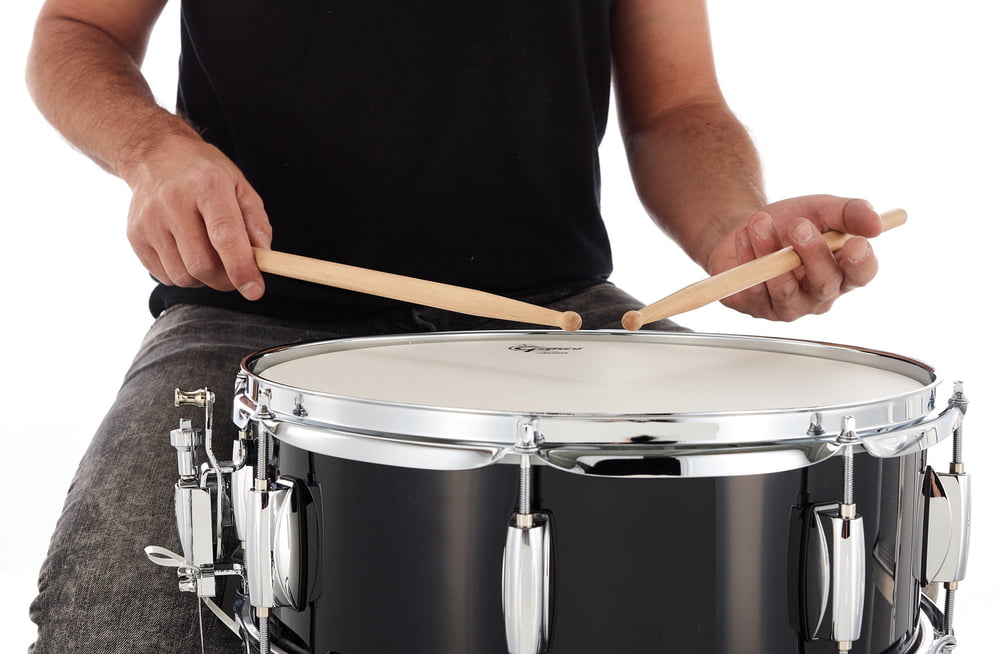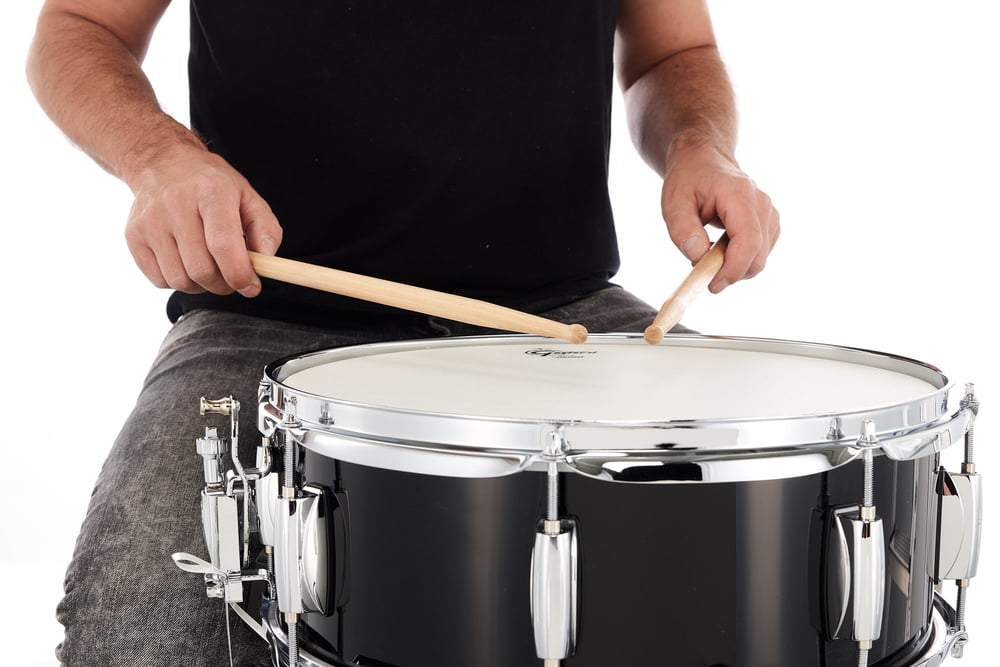8. Hand Position and Grip
The following refers to a right-handed playing style; left-handed drummers should reverse these instructions. Sit behind the drum at a comfortable position. There are two main ways of holding the sticks: traditional grip and matched grip.
Traditional grip is sometimes thought of as the jazz grip, since it is associated with early jazz drummers, though its use pre-dates them. It was originally developed to accommodate large marching snare drums, which were hung from straps and rested on a drummers left hip or leg at a steep angle. The grip became the standard way drummers played for many years and was then adopted by kit drummers in the early twentieth century. The stick is gripped in the webbing between the thumb and first finger, and this is the fulcrum of this grip. The shaft of the stick lies between the second and third finger. The stick is moved in a twisting motion up and down, similar to the act of shaking water from your fingertips though the first finger and thumb pressure at the fulcrum are also used to influence its motion. Rudimental drummers know that the back of the hand should be kept fairly parallel to the floor for more playing power and the middle finger should be kept fairly straight, but many drum kit players dont follow that advice. The thumb, first, second and third finger are used to control the stick. Many Jazz drummers play this grip because the steeper angle of the left stick allows for quick buzzes and lends itself to lower dynamic levels. Rudimental drummers like it because of its rich history as well as the additional visual effects (such as twirls and back sticking) that the grip offers.

Traditional grip hand position
The other grip is called matched grip, and it became more popular with the advent of Rock music, since it allows drummers to play more loudly than traditional grip usually does. Each hand holds the stick identically, hence the name. In matched grip the sticks are held palm down with the fingers wrapped around the stick holding the stick along the first knuckle of each finger. The stick is moved straight up and down in a motion similar to patting a dog on the head. For better control, the thumb should point towards the tip of the stick, not below it and should rest flat on the stick. There are a few variations of this grip, using different hand angles but palm down is considered the easiest to develop and is preferred by rudimental drummers.
Debate over the supremacy of one grip over another abounds. However, matched grip has become far more popular than traditional grip for several reasons. One is simply it that it is easier to teach and learn than traditional grip. Drummers who play traditional grip often struggle to get their trad hand equal to their matched grip hand because matched grip and its straight up/down motion seems more natural than the unusual soup spoon grip and twisting motion of traditional grip. Another reason is that matched grip is also the grip used for playing other percussion instruments such as marimba and tympani. Lastly, matched grip is much more popular with rock drummers, and is often the first grip attempted by beginning drummers. However, dont worry: traditional grip is not going away. Many of the worlds finest drummers use it, and it remains the favourite grip of most jazz and rudimental drummers. Many professional drummers who originally learned traditional grip switch back and forth between it and matched grip depending on what feels comfortable to them. Its not surprising to see a drummer who usually plays matched suddenly play brushes or jazz with traditional grip because it fits that application better.
Many drummers advocate holding the stick lightly so it can move relatively freely. Heres the catch: the looser your grip, the freer the stick can move but the less control youll have over it. This is why many rudimental drummers play with a closed but not tight grip at slow to medium speeds and loosen up as necessary when the speed increases, since this allows them to more accurately control the timing and height of their sticks. An excessively tight white knuckle grip and unnecessary tension in the wrist should always be avoided since they can cause repetitive stress injury and prohibit a fluid motion and sound.

Rock hand position
Drummers who play using traditional grip sometimes angle the drum to the right or forward to accommodate the angle that their left stick strikes the drum, while matched grip drummers often leave their drum flatter to allow for easy rim shots though sometimes tilt the drum slightly towards them. You should experiment with both grips to see which seems more comfortable to you.




